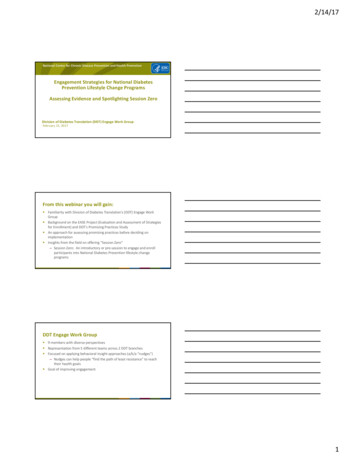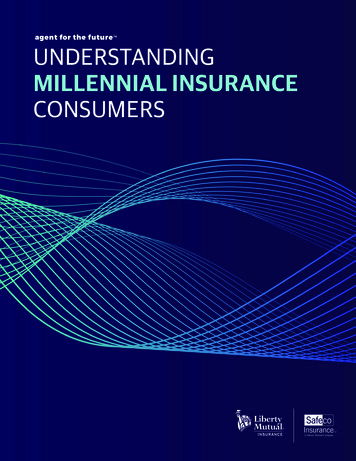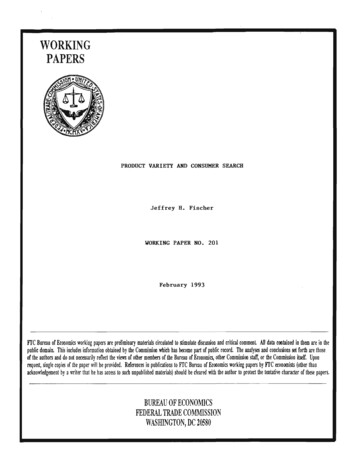
Transcription
HOW DIGITAL NUDGES INFLUENCE CONSUMERS –EXPERIMENTAL INVESTIGATION IN THE CONTEXT OFRETARGETINGResearch in ProgressEigenbrod, Laura, University of Kassel, Kassel, Germany, laura.eigenbrod@wi-kassel.deJanson, Andreas, University of Kassel, Kassel, Germany, andreas.janson@uni-kassel.deAbstractRetargeting is an innovative online marketing technique in the modern age. Although this advertisingform offers great opportunities of bringing back customers who have left an online store without a complete purchase, retargeting is risky because the necessary data collection leads to strong privacy concerns which, in turn, trigger consumer reactance and decreasing trust. Digital nudges – small designmodifications in digital choice environments which guide peoples’ behaviour – present a promisingconcept to bypass these negative consequences of retargeting. In order to prove the positive effects ofdigital nudges, we aim to conduct an online experiment with a subsequent survey by testing the impactsof social nudges and information nudges in retargeting banners. Our expected contribution to theoryincludes an extension of existing research of nudging in context of retargeting by investigating the effectsof different nudges in retargeting banners on consumers’ behaviour. In addition, we aim to providepractical contributions by the provision of design guidelines for practitioners to build more trustworthyIT artefacts and enhance retargeting strategy of marketing practitioners.Keywords: Retargeting, Digital nudging, E-commerce, Consumer behaviour.1Introduction23% of the German companies stated that the share of their online advertising budget on the overalladvertising budget was 80% or more in 2016 (Statista, 2016). Another study shows that spending ononline advertising in Europe increased by 35.2 billion between 2006 and 2016 (IAB Europe, 2017).Hence, many advertisers are confronted with intense competition concerning consumer attention in ecommerce (Frick and Li, 2016). For that reason, advertisers are constantly looking for new and innovative online marketing techniques which offer opportunities to adapt the advertising messages to the behaviour and preferences of the consumers (Zarouali et al., 2017).Retargeting is one of these innovative techniques (Zarouali et al., 2017) and denotes the use of bannersthat represent personalised advertising content based on consumers' browsing behaviour on recentlyvisited websites (Bleier and Eisenbeiss, 2015). Retargeting banners approximately reach 75% of customers, i.e., they explicitly take notice of the banners, and around 40% call the personalised bannershelpful within their buying process (GreenAdz, 2015). On the one hand, the browsing behaviour offersan adequate possibility to meet the preferences of consumers through targeted advertising content (Lambrecht and Tucker, 2013). On the other hand, retargeting is risky because consumers may feel observedand constrained (White et al., 2008) which may in turn raise privacy and security concerns (King andJessen, 2010). These concerns may be reflected through poor click-through-rates and conversions.Building trust in each online retailer can help consumers feel safe, reduce their concerns and, as a result,improve retargeting performance (Bleier and Eisenbeiss, 2015). In this context, the application of digitalnudges in information systems (IS) – small design modifications in digital choice environments whichguide peoples’ behaviour (Weinmann et al., 2016) – seems to be a promising concept in this area toavoid the problems of retargeting by increasing trust in online retailers and positively influencingTwenty-Sixth European Conference on Information Systems (ECIS2018), Portsmouth, UK, 2018
Eigenbrod and Janson / Digital Nudges in Retargetingconsumers' behaviour. However, there is a lack of research regarding nudging in context of retargetingwhich should be addressed in this research-in-progress paper by examining the impact of nudges inretargeting banners on consumers’ behaviour. Hence, the main objective of this study is to close thisresearch gap and shed light on the application and design of suitable nudges in retargeting banners byconducting systematic and experimental investigation. The guiding research question (RQ) for our overall study is as follows:RQ: How effective are social and information nudges to influence consumers’ behaviour and the antecedents of consumers’ behaviour?With our completed research, we expect to provide answers to our RQ as well as a more detailed understanding of digital nudge design in e-commerce contexts. Our study addresses the interface of marketingand IS, thus contributing to the greater body of knowledge with a theory of explanation and prediction(Gregor, 2006) concerning the impact of digital nudges in the context of retargeting. The remainder ofthis research-in-progress paper is structured as follows. First, we provide a brief overview of the theoretical background of retargeting, digital nudging and the Stimulus-Organism-Response Model (SOR).Next, we develop our hypotheses and theoretical model. In section four, we present the research methodto evaluate the theoretical model, before we close with an overview of our expected contribution andnext steps.2Theoretical Foundations2.1RetargetingRetargeting is a form of online marketing designed to target customers based on their online activities(Ghose and Todri, 2016). Thanks to the personal browsing behaviour, the advertising content can beadapted to their personal preferences (Schellong et al., 2017; Zarouali et al., 2017). Retargeting seemsto be a promising strategy to bring back potential customers (Yeo et al., 2017) because over 95 % of theinternet users leave an online shop without a completed purchase (Fösken, 2012). As we can see, retargeting only addresses customers who have already visited the website (Yang et al., 2015). An often usedtracking technology is the application of so-called cookies which identifies the internet users (Lambrechtand Tucker, 2013). The most prominent forms of retargeting are the generic and the dynamic retargeting(Schellong et al., 2016). Whereas the generic retargeting is characterized only by general images of thepreviously visited website with, for example, the logo of the brand, the advertising banner of dynamicretargeting is marked by the actual products the potential consumer has previously looked at (Lambrechtand Tucker, 2013). Although on the one hand, the underlying personalisation of retargeting leads tohigher advertising relevance for the consumers (Tsekouras et al., 2016), on the other hand, the consumers understand the accumulation of their data as a kind of attack on their privacy (Awad and Krishnan,2006). Consequences are increasing advertising avoidance (Baek and Morimoto, 2012), negative attitudes and lower purchase intentions (Yu and Cude, 2009). The underlying phenomenon could be relatedto the personalisation-privacy-paradox which denotes the dilemma between the rising application ofpersonalised advertising and the increasing privacy concerns of the consumers (Lee et al., 2011; Sutantoet al., 2013; Taylor et al., 2009). The increasing privacy concerns can result in immense negative impactson consumers’ trust in the e-retailer and their behavioural intentions which, in turn, threaten the successof retargeting itself. An opportunity to build trust in the e-retailer as well as to positively influenceconsumers’ behaviour is the integration of digital nudges in the retargeting banners. For that reason, weintroduce in the next section the theoretical assumptions of nudging in digital environments.2.2Digital NudgingThe nudge theory – originally derived from behavioural economics (Mirsch et al., 2017) – is based onthe irrational behaviour of human beings (Weinmann et al., 2016). A nudge “is any aspect of the choicearchitecture that alters people’s behaviour in a predictable way without forbidding any options or significantly changing their economic incentives” (Thaler and Sunstein, 2008, p. 6). The design of choicearchitecture by nudges is called nudging (Mirsch et al., 2017). The previous focus of the nudging conceptTwenty-Sixth European Conference on Information Systems (ECIS2018), Portsmouth, UK, 2018
Eigenbrod and Janson / Digital Nudges in Retargetingwas mainly in offline contexts (Djurica and Figl, 2017; Schneider et al., 2017; Weinmann et al., 2016)and is applied in almost all areas of life, like the health service/medicine (e.g., Johnson and Goldstein,2003; Lehmann et al., 2016), food consumption (e.g., Guthrie et al., 2015), personal finance (e.g., Rodriguez and Saavedra, 2015; Thaler and Benartzi, 2004), politics (e.g., Alemanno and Spina, 2014) orcharity (e.g., Croson and Shang, 2008). One prominent nudging example is the use of default options aspart of organ donor systems where the changing from opt-in to opt-out leads to a higher percentage oforgan donors (Weinmann et al., 2016).As more and more decisions are made online today, such as purchases, holiday bookings, insurancesand so on, nudging is becoming increasingly important in the digital context as well (Mirsch et al.,2017). “Digital nudging is the use of user-interface design elements to guide people’s behaviour in digital choice environments” (Weinmann et al., 2016, p. 433). It should however be emphasized that it ismerely a subtle form of influence that preserves an individuals' freedom of choice (Meske and Potthoff,2017). Digital choice environments are, e.g., websites or mobile applications (Weinmann et al., 2016).The following table presents application examples of nudges in the e-commerce context:NudgeExamplePsychological EffectSourceProduct RecommendationPresentation of product-similar articles on product pagesFramingMirsch et al., 2017Pressure CueProduct limitation (e.g., limited hotel rooms)Loss AversionAmirpur and Benlian,2015; Djurica and Figl,2017Social InfluenceCueSocial Popularity (number of likes)Social NormsYi et al., 2014DisclosureDisclosure of privacy policyPrimingBansal et al., 2008; Bernardand Makienko, 2011; Panand Zinkhan, 2006DefaultsMaking a preselection by settingdefaults, e.g. a travel insuranceStatus Quo BiasMirsch et al., 2017Table 1.Social Rankings (product ratings)Deng et al., 2016Application examples of nudges in the e-commerce contextAs seen in the examples above, nudging in the field of e-commerce is a proliferating research. However,up until now, attempts to integrate rigorous research to experimentally test the effects of different nudging possibilities remain scarce.2.3Stimulus-Organism-Response ModelTo guide the theory development, we draw on the SOR model of Mehrabian and Russell (1974) whichstems from environmental psychology. It proposes that environmental stimuli (Stimulus) influence thepsychological processes of the individuals (Organism) which, in turn, impacts the individual behaviour(Response) (Mehrabian and Russell, 1974). Due to the fact that the SOR-Model has been widely appliedto e-commerce and online shopping (e.g., Amirpur and Benlian, 2015; Eroglu et al., 2003; Peng andKim, 2014; Sheng and Joginapelly, 2012; Xu et al., 2014), and on top of that in the digital nudgingcontext (Hummel et al., 2017), it is also suitable for this study.The stimuli arouse individuals’ attention and denote all hints influencing consumers (Eroglu et al.,2001), such as products, brands or logos (Jacoby, 2002). The organism describes the cognitive and/oraffective processes between the stimulus and the response (Eroglu et al., 2001). Responses are, for example, the willingness to buy or rejection (Sheng and Joginapelly, 2012). Adapted to the underlyingcontext, the stimuli are the nudges as part of the retargeting banners, the organism presents the cognitiveprocesses which are triggered by the nudges and the response is the behaviour of the consumers whichrefers in our experimental setting to a hotel booking process. Thus, responses of the participants shouldbe measured through booking behaviour as an endogenous variable.Twenty-Sixth European Conference on Information Systems (ECIS2018), Portsmouth, UK, 2018
Eigenbrod and Janson / Digital Nudges in Retargeting3Hypotheses DevelopmentWe derive in the following a comprehensive theoretical model that enables us to research the consequences of digital nudging. To overcome the aforementioned challenges of nudging research in e-commerce, we draw as a theoretical framework for the model on the SOR model. When focusing on thestimuli as highlighted in the SOR model, we recognise the impact of social nudges and informationnudges, as well as their combined impact on our endogenous variables. We decided to explore these twonudges because, on the one hand, they are highly suitable for retargeting banners and, on the other hand,existing research regarding the experimental testing of these two nudges remain scarce. Thus, we derivein the following according hypotheses related to the impact of digital nudging.Social NudgesSocial nudges indicate how popular a product is by showing how many people already bought it or likedit (Yi et al., 2014) or by presenting customer reviews (Deng et al., 2016). The majority’s decision influences perception and behaviour of individuals in a way (Zhang and Xu, 2016) that others get the feelingof trying to imitate the behaviour of the majority (Coventry et al., 2016). The more people have the sameopinion on a particular topic, the more likely it is to elicit the same opinion in others (Wang and Chang,2013) because behaviour of like-minded people leads to individual behaviour (Bakshy et al., 2012). Assuch, the individual perceived risk of repentance after a purchase decision decreases if other consumershave made the same decision (Wang and Chang, 2013) which, in turn, makes the own purchase morelikely. Furthermore, consumers worry less because others do the same too, which, in turn, leads to lowerprivacy concerns (Nov and Wattal, 2009; Zhang and Xu, 2016). Concerning the application of socialnudges in retargeting banners, nudges may indicate that other customers as well as friends like thehomepage of the retailer too or also have used the booking service. This suggests that other people havealso committed to and rely on the online retailer, which could reduce the individual privacy concernsand increases the actual buying behaviour (in this study booking behaviour), since individuals imitatethe behaviour of their peers. Therefore, we hypothesize:Hypothesis H1: The provision of social nudges in retargeting banners negatively influences consumers’ privacy concerns.Hypothesis H2: The provision of social nudges in retargeting banners positively influences consumers’booking behaviour.Information NudgesInformation nudges disclose the e-retailer’s privacy policy and the purpose of retargeting itself. Theadvances in technology are steadily improving the collection, storage and dissemination of personalinformation, which at the same time means that consumers sometimes have no knowledge of the use oftheir data and thus lose control of the dissemination of their personal information (Arcand et al., 2007).The disclosure of these procedures provides transparency which is appreciated by the consumers (Steffelet al., 2016) and which, in turn, decreases consumers’ concerns (Miyazaki and Fernandez, 2000) towardsusing the booking service and, therefore, may increase booking behaviour. This is the case because onlythe mere presence of privacy policy already has a positive impact on consumers’ perceived control (Arcand et al., 2007). Perceived control denotes the idea of consumers to influence the collection and distribution of their personal data (Xu et al., 2010; Xu et al., 2012). The application of information nudgeswith an emphasis on nudging privacy in retargeting banners is suitable to create transparency and toavoid the personalisation-privacy-paradox (Lee et al., 2011; Sutanto et al., 2013; Taylor et al., 2009).Since consumers aren’t well aware of whether the e-retailer is acting in their interest or in the interestsof the e-retailer, information nudges can help to make the consumer understand that the e-retailer isacting in their favour. Thanks to personalisation, consumers are only shown products based on theirpersonal preferences. At the same time, this could have a positive effect on the consumers’ perceivedcontrol of their personal data and on top of that, on their booking behaviour. Thus, we hypothesize:Hypothesis H3: The provision of information nudges in retargeting banners positively influences consumers’ perceived control.Hypothesis H4: The provision of information nudges in retargeting banners positively influences consumers’ booking behaviour.Twenty-Sixth European Conference on Information Systems (ECIS2018), Portsmouth, UK, 2018
Eigenbrod and Janson / Digital Nudges in RetargetingPrivacy and TrustConsumers tend to have lower privacy concerns if they have the feeling of controlling their personaldata (e.g., Dinev and Hart, 2004; Milne and Boza, 1999; Wilson et al., 2015; Xu, 2007). According toWestin (1967), privacy concerns are the ability to control the collection and use of personal data. Forthat reason, it is obvious that individual privacy concerns are to a certain extent generated by the feelingthat they no longer have control over the collection and use of personal data (Hong and Thong, 2013).In consequence, the negative relationship between consumers’ perceived control and their privacy concerns could be a logical consequence. Thus, we hypothesize:Hypothesis H5: Consumers‘ perceived control negatively influences consumers‘ privacy concerns.The reactance theory according to Brehm (1966) proposes that a limitation of freedom leads to reactance- a psychological resistance (White et al., 2008). Following this theory, consumers’ privacy concerns,which are triggered by the loss of control over personal information, can be understood as fear of arestriction of freedom. In accordance with previous literature (e.g., Chen et al., 2017; Park, 2009), weassume a positive relationship between consumers’ privacy concerns and their reactance. This ultimatelyleads to the following hypothesis:Hypothesis H6: Consumers‘ privacy concerns positively influence consumers‘ reactance.Instead of hypothesizing the direct influence of privacy concerns on trusting beliefs, we hypothesizethat the perceived loss of freedom that is triggered by reactance towards retargeting banners can have anegative impact on consumers’ confidence and trusting beliefs (Lee et al., 2014). A differentiation ofthe trust concept in trusting beliefs – consumers’ perceptions towards the e-retailer (Bartikowski andMerunka, 2015) – and trusting intentions – intent of the trustor to become dependent on the trustee(McKnight et al., 2002) – suggests a negative relationship between consumers’ reactance and their trusting beliefs towards the e-retailer. For that reason, the following hypothesis is assumed:Hypothesis H7: Consumers‘ reactance negatively influences consumers‘ trusting beliefs towards thee-retailer.Based on the theory of reasoned action of Fishbein and Ajzen (1975), which states that beliefs lead toattitudes which, in turn, lead to intentions and finally to behaviour and the trust model of McKnight etal. (2002), trusting beliefs lead to trusting intentions. On top of that, literature streams of e-commercewere able to prove that trusting beliefs positively influence trusting intentions (e.g., Dimitriadis andKyrezis, 2010; Janson et al., 2013; Kim and Kim, 2011; Lowry et al., 2008). Thus, we hypothesize:Hypothesis H8: Consumers‘ trusting beliefs positively influence consumers‘ trusting intentions towards the e-retailer.Since previous research was able to prove strong correlations between intentions and actual behaviour(e.g., Sheppard et al., 1988; Venkatesh and Davis, 2000), we assume a positive relationship betweenconsumers’ trusting intentions and their actual booking behaviour. If customers are willing to trust retailers for example in handling sensitive credit card information, they will also be more likely to makea transaction on an e-commerce platform. Thus, we hypothesize:Hypothesis H9: Consumers‘ trusting intentions positively influence consumers’ actual booking behaviour.Furthermore, we assume that a combination of both nudges leads to a cognitive overload because consumers have to process the recurring banner, the user interface of the homepage and two differentnudges. The combination of all three aspects presents a high degree of cognitive load and, in turn, leadsto an unmanageable flood of information. Ding et al. (2017) proved that information overload leads tobrowsing fatigue and negatively affects purchase decisions. Thus, we hypothesize:Hypothesis H10: The information nudge in retargeting banners negatively moderates the effect of socialnudges in retargeting banners on consumers’ booking behaviour.Our research model with the underlying hypotheses is depicted in the following figure:Twenty-Sixth European Conference on Information Systems (ECIS2018), Portsmouth, UK, 2018
Eigenbrod and Janson / Digital Nudges in RetargetingOrganismStimuli: ocial NudgeH3H2H10H4Information NudgeFigure 1.4BookingBehaviourResearch ModelResearch Design and MethodTo test the underlying hypotheses of the research model, we conducted an online experiment with asubsequent survey. The survey was completed by 255 participants with 195 valid data sets. They wererecruited on several social media platforms and in university courses to reach a diverse audience that isalso targeted by e-commerce platforms. The following figure shows the experimental process.Figure 2.Experimental processThe experiment proceeds as follows: Within the online experiment, the participants first receive an exactdescription of the procedure. In the first step, they are asked to search for hotels on a holiday island onthe fictitious homepage “mytravelness”. They receive a selection of three hotels and are asked to chooseone. After the selection, in the presented scenario the booking process is aborted because some thingshave to be checked before the final booking. The participants are asked to visit the fictitious socialnetwork “Networking” to check with a friend whether he could drive them to the airport. Furthermore,they are asked to look how the weather will be at the holiday location by visiting the fictitious homepage“island weather”. At the end, they are asked to check their fictitious bank balance by visiting an onlinebanking site. On these three homepages they are repeatedly confronted with the retargeting banner ofthe hotel booking homepage “mytravelness”. As a last step, the participants are asked to continue thebooking process by clicking on a banner of “mytravelness”. In this last step, participants could freelydecide whether they would book the hotel with “mytravelness” or not before continuing. Following thisset-up, they are directed to the survey, where they are asked to answer two questions about theTwenty-Sixth European Conference on Information Systems (ECIS2018), Portsmouth, UK, 2018
Eigenbrod and Janson / Digital Nudges in Retargetingexperiment content to ensure that the experiment was conscientiously completed. After that, we checkthe experimental manipulation by three items in order to ensure that participants recognize the nudgespresented in their experimental group.The online experiment is based on a between-subject design with a control group and three treatmentgroups as presented in Table 2. Following this design, the treatment groups are only exposed to onetreatment and the assignment of the subjects to the groups is randomized (Charness et al., 2012).GroupNudgeControl Group/Treatment Group 1Social NudgeTreatment Group 2Information NudgeTreatment Group 3Social and Information NudgeTable 2.Overview of groupsThe design of the social nudge follows a social popularity statement which indicates how many fictitiousfriends like the hotel booking homepage “mytravelness”. In accordance with Wang et al. (2013), thepresentation of profile pictures ought to create a clear idea of which friends like the homepage to increaseattention. The information nudge contains an info icon which discloses the privacy policy of “mytravelness” and the purpose of the retargeting banner. All experimental conditions were pre-tested to ensuremanipulation. Figure 3 shows the retargeting banners with the two different nudges.Figure 3.Exemplary retargeting banner with nudgesCommon method variances that are caused by the measurement method rather than the constructmeasures were also taken into account considering the latent constructs (Podsakoff et al., 2003). According to Podsakoff et al. (2003), these biases can be controlled by several procedural remedies whichwere also used in the present study. In order to ensure a psychological separation of measurement, wedid not reveal the purpose of the experiment and provided a cover story. Additionally, we assured theanonymity of the participants. In order to control for effects such as socially desirable responses(Paulhus, 2002), we assured that there were no wrong answers and that the respondents answered questions as honestly as possible (Podsakoff et al. 2003). Finally, instead of just relying on behaviouralintentions, we decide to measure the response through the actual booking behaviour of the participantswhich, in turn, presents an endogenous variable.For the operationalization of our research model, we use well-established scales and adapt them to thecontext of digital nudging and retargeting. Table 3 shows the latent construct measures and, if applicable, corresponding literature sources of the indicators.Twenty-Sixth European Conference on Information Systems (ECIS2018), Portsmouth, UK, 2018
Eigenbrod and Janson / Digital Nudges in RetargetingLatent ConstructLatent Construct TypeLiterature SourcePerceived ControlReflectiveZhang and Xu, 2016Privacy ConcernsReflectiveBleier and Eisenbeiss, 2015ReactanceReflectiveTrusting BeliefsReflectiveWang and Benbasat, 2008Trusting IntentionsReflectiveMcKnight et al., 2002Table 3.Measurement of constructs and literature sourcesWe measure all latent variables with reflective indicators. For this purpose, we evaluated the measurement instrument with regards to its suitability to measure the constructs in a reflective manner. This wasdone by checking the reflective constructs according to the guidelines of Jarvis et al. (2003). We use a7-point Likert response format to assess the indicators. The experimental manipulations are coded asbinary variables. In addition, we measure booking behaviour through the behaviour of the participantsin the experimental environment, also with a binary coding. To increase statistical power and reliabilityof our results, we use instruction manipulation checks to detect participants that do not read and followour instructions (Oppenheimer et al., 2009). We controlled for disposition to value privacy, dispositionto trust and shopping experience.To evaluate the proposed research model in this study, we use structural equation modelling with thevariance-based partial least squares (PLS) approach (Chin, 1998b; Wold, 1982). We chose this approachbecause it is more suitable to identify key constructs than covariance-based approaches (Hair et al.,2011), while also being capable to deal with the sample size of 195 data sets (Chin, 1998a; Hair et al.,2014). We use SmartPLS 2.0 M3 (Ringle et al., 2005) as well as SPSS 24 (for descriptive analysis aswell as testing differences across groups and interaction effects) as our tools of analysis.5Expected Contribution and OutlookOur expected contribution is twofold. On the one hand, we contribute with our theory of explanationand prediction (Gregor, 2006) to existing research of nudging in context of retargeting by evaluating theeffects of nudges in retargeting banners on consumers’ behaviour. On the other hand, we provide guidance for marketing practitioners with design guidelines for a retargeting that is perceived as less intrusive, more trustworthy and ultimately leading to a higher booking behaviour. Hence, we account forboth IS research through nudging design guidelines that can also be used for facilitating design scienceresearch, as well as marketing research through the enhancement of the retargeting method. With ourcompleted research, we aim to provide effective nudges that increase marketing performance. This enables practitioners to ensure that retargeting strategies are improved which, in turn, leads to, for example,higher conversion rates in the long run. First and foremost, we would like to show that the thoughtfulconsideration of digital nudges leads to a desirable state of consumer behaviour and therefore contributesto the success of effective retargeting strategy. Otherwise, the use of nudges that are not aligned to theneeds of consumers can lead to increasing privacy concerns, cognitive overload and failure of the retargeting strategy. As highlighted by Schneider et al. (2018), goal setting, understanding users as well assystematic design and experimental testing is crucial for the success of nudging. Based on the insightswe gained from the experiment, we will formulate design principles (DPs) as prescriptive designknowledge (Chandra et al., 2015). These DPs can be applied by practitioners related to IS design as wellas marketing practice to develop more effective advertisement and retargeting strategies. Second, andin consideration with the embeddedness of retargeting nudges in marketing campaigns, our findingshave several implications, e.g., regarding the optimal retargeting form or the adaption of the duration ofthe banner displaying. As an outlook, our next steps are concerned with the data analysis and the communication of our research results in a comple
EXPERIMENTAL INVESTIGATION IN THE CONTEXT OF RETARGETING Research in Progress Eigenbrod, Laura, University of Kassel, Kassel, Germany, laura.eigenbrod@wi-kassel.de Janson, Andreas, University of Kassel, Kassel, Germany, andreas.janson@uni-kassel.de Abstract Retargeting is an innovative online marketing technique in the modern age.










